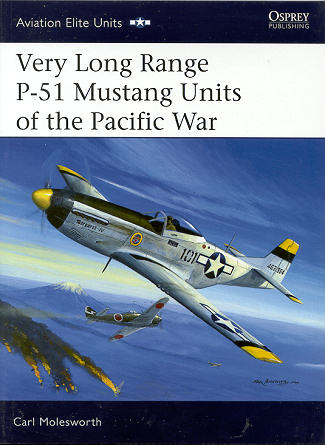 A rather
hefty book from Osprey is this edition on Very Long Range Mustang Units of the
Pacific War. These are the aircraft that were based on Iwo Jima during the last
part of the war against Japan. The fighter groups involved are those that were
home based in Hawaii and saw only limited combat during the central Pacific
campaign while flying P-40s and P-39s. During early 1945 they transitioned to
the P-51 and after brief training on the type, were hauled aboard jeep carriers
and off-loaded on Guam. Then they were flown to Saipan/Tinian and from there, to
Iwo Jima.
A rather
hefty book from Osprey is this edition on Very Long Range Mustang Units of the
Pacific War. These are the aircraft that were based on Iwo Jima during the last
part of the war against Japan. The fighter groups involved are those that were
home based in Hawaii and saw only limited combat during the central Pacific
campaign while flying P-40s and P-39s. During early 1945 they transitioned to
the P-51 and after brief training on the type, were hauled aboard jeep carriers
and off-loaded on Guam. Then they were flown to Saipan/Tinian and from there, to
Iwo Jima.
Upon their arrival they had to set up while the fighting was
still on-going and their first missions were in support of the Marines against
those Japanese still holding out. It wasn't until 30 March that the first very
long range mission to Japan was flown. By all accounts 8 hours in the seat of a
fighter is one that most pilots would dread and often the ground crews had to
lift the stiff and sore pilot from his aircraft upon landing.
The arrival of escort fighters was quite an unpleasant
surprise for the Japanese defenders and early battles allowed the Mustang pilots
a chance to get a number of kills. Later, picking were slim as the Japanese were
hoarding their aircraft in anticipation of an invasion which never came.
Carl Molesworth has done a lot of research into the three
units involved: the 15th, 21st and 506th fighter groups. Their early history is
briefly covered to give a background and then it is into their operations from
Iwo Jima. It is in a chronological sequence starting with the 15th then the 21st
and finally the 506th as they arrived and started work.
The book is an easy read thanks to the author's fluid writing
style. There are a lot of well done photographs to help illustrate the book and
30 nicely drawn profiles of the aircraft involved.
This is the first book I've seen on the subject and it covers
it well. I enjoyed reading it and I know that you will too. It is one that I can
highly recommend to Mustang fans and students of the Pacific war.
As a bit of an aside, you all probably know that the number
of squadrons in the air force today are a mere pittance of those at the height
of WWII. The USAF tries to keep alive some of the more famous units, even if it
means that the squadron is no longer flying the same mission. Reading this book,
I discovered that less than 5 miles from me is one of the units that was with
the 506th FG. Today, the 458th is not flying fighters but C-21A Lear jets as the
458 AS/375 AW.
September 2006
For more on the complete line of Osprey books,
visit www.ospreypublishing.com. In the US, it is
Osprey Direct at 44-02 23rd St, Suite 219, Long Island City, NY 11101., where you can
get a catalogue of available books.
If you would like your product reviewed fairly and quickly by a
site that has nearly 325,000 visitors a month, please contact
me or see other details in the Note to
Contributors.
 A rather
hefty book from Osprey is this edition on Very Long Range Mustang Units of the
Pacific War. These are the aircraft that were based on Iwo Jima during the last
part of the war against Japan. The fighter groups involved are those that were
home based in Hawaii and saw only limited combat during the central Pacific
campaign while flying P-40s and P-39s. During early 1945 they transitioned to
the P-51 and after brief training on the type, were hauled aboard jeep carriers
and off-loaded on Guam. Then they were flown to Saipan/Tinian and from there, to
Iwo Jima.
A rather
hefty book from Osprey is this edition on Very Long Range Mustang Units of the
Pacific War. These are the aircraft that were based on Iwo Jima during the last
part of the war against Japan. The fighter groups involved are those that were
home based in Hawaii and saw only limited combat during the central Pacific
campaign while flying P-40s and P-39s. During early 1945 they transitioned to
the P-51 and after brief training on the type, were hauled aboard jeep carriers
and off-loaded on Guam. Then they were flown to Saipan/Tinian and from there, to
Iwo Jima.